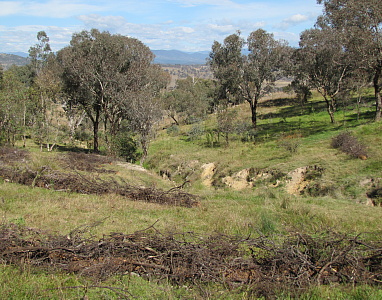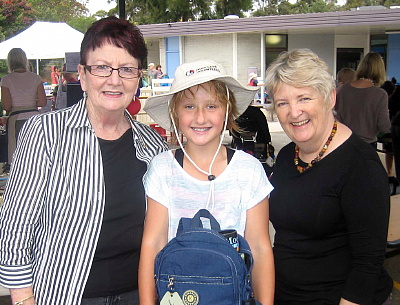  |
news archive |
|
Archived News Items from 2012 13 December 2012: Weeding Effort updated After a lapse of a couple of months, the weeding effort summary to the end of November 2012 is now on the web site. After a relatively quiet start to the year, November has been a very busy month of weed control, with 193 hours being invested, exactly half of which was spraying (primarily of St. John's Wort, Verbascum virgatum, and Thistles). Every weeding season is different, and this one is no exception. It started with much more Paterson's curse than we've seen for many years, an early burst of thistles, then the flourishing of st. John's Wort and V. virgatum. Briars are also having another "good" year, with spraying of them having recently commenced, while Verbascum thapsus is almost entirely absent, a combination of intensive spraying last season eliminating most over-wintering plants and the dry weather curbing new germination and growth. Overall, the weed situation on the Reserve seems a little more under control than previously, possibly because of the very dry spring (although we had similar total rainfall to previous years, it fell on only a handful of days and with higher temperatures this year has not recharged the soil). A greater percentage of our time has therefore been able to be spent tackling threats of weed invasion from the neighbouring Bottom Pinnacle and North Kama paddocks. This report also sees the introduction of some new ways of viewing the data, such as month-by-month comparisons of the effort for different weed species. 24 November 2012: Greening Australia celebrates 30 years In 2012 Greening Australia is celebrating 30 years of achievement. 30 years of working with people from across diverse groups to make a meaningful difference to the health of our local landscapes. Volunteers, staff, farmers, Landcare Groups, partners and stakeholders all have a tale to tell, and are able to do so through GA's celebratory project at http://1minutein30years.blogspot.com.au/, a collection of 1 minute video blogs telling of their experiences with Greening Australia. Some of our members have already recorded blogs - worth checking out. If you would like to make a contribution to this project, and tell your tale, get your camera out and send your story in a one minute video to admin@act.greeningaustralia.org.au, or ring (02) 6235 3035. 25 September 2012: Bush Friendly Garden at Floriade – volunteers needed Floriade is on until mid-October. If you'd like to help out at the Bush Friendly Garden as an explainer, download and have a look at the schedule. There are still some gaps in the volunteer schedule from 10am – 1.00pm or 12 noon - 3.00pm on various days. If interested, give Rosemary Blemings a call on 62584724. It's a wonderful experience and improves your ability to understand and speak about weeds and their problems in the environment. You'll also meet people from all over Australia, and often from overseas. 16 September 2012: fotpin Family Planting Day, 2012 Spring 2012 got off to a flying start for fotpin with 35 volunteers attending our Family Planting Day on September 1st. Greening Australia is contracted by the ACT Government under the Plan to undertake a range of restoration activities, including supporting parkcare group planting events such as ours, as part of the Act Government's $1M Woodlands Restoration Plan, being implemented across the Belconnen Hills woodland corridor. Roughly 450 tubestock, including Yellow Box (E. melliodora), Blakely's Red Gum (E. blakelyii) and Native Blackthorn (Bursaria spinosa), were planted along both sides of Deep Creek in Bottom Pinnacle, and are clearly visible looking south from the pumphouse on the Boundary Track. We were very fortunate to have the ACT Minister for Environment and Sustainable Development, Simon Corbell MLA, join us and help with the plantings, and share with us his views on The Pinnacle, the Belconnen Hills corridor and the Woodlands Plan. Having completed the planting by lunchtime, everyone tucked into a sausage sandwich or two and left satisfied at a job well done. Fotpin weeders agreed the general area of this planting becomes a new priority for our weed control activities. Thanks very much to the Greening Australia team, led by Ian Rayner. For more information see fotpin's Revegetation Activities or the 2012 Planting Day photo gallery.
13 September 2012: fotpin Grass Experiment Findings from 2011 Spring Surveys Findings from the first Spring surveys of our Grass Experiment (see defeating the weed menace for details) have been released - 2011 Spring Survey Findings [ Key findings include:
13 September 2012: Weeding Effort updated The weeding effort summary for July and August 2012 is now on the web site. It has been a relatively quiet couple of months for weeding, with many of the priority weed species close to being (temporarily) under control on the Reserve. Nevertheless, the effort put in closely matched the target in the Weed Plan. About half the effort was put in on the neighbouring paddocks - North Kama and Bottom Pinnacle, where the weed control is nowhere near as satisfactory as on the Reserve, and we are taking what steps we can to minimise the re-infestation of the Reserve from that quarter. With Paterson's curse and Thistles now in rapid growth and development, spraying started in earnest in September and the next update should show an acceleration of effort. 23 August 2012: Kangaroo count 2012 On Sunday 19 August 2012, ACT Parks and Conservation Service and fotpin conducted the second kangaroo survey of The Pinnacle Nature Reserve and adjacent lands. The survey employed the sweep count methodology used in 2011. Thanks very much to the 47 adults and 4 children who volunteered to help with the count, ensuring plenty of help to form a line between Springvale and William Hovell Drives, over a distance of up to 1.7km for both the morning and afternoon counts. The average of the two counts was 677. This is less than the number estimated from the sweep counts in 2011, which is consistent with the population having been culled by the ACT Government in June 2012, and with the reduced feed available in 2012 compared with 2011 (putting natural pressure on the population). See the full report: Kangaroo Count 2012 15 August 2012: Gully erosion control works continue in Bottom Pinnacle On Saturday 11 August 12 fotpins made further progress on our erosion control program. With the support of ACT Parks and Conservation Service, we installed a further 105 coir logs adjacent to and within eroding drainage lines in the Bottom Pinnacle, extending the work carried out in April. At least another 15 coir logs are required to finish the works in this area. When Parks supply us with the additional logs we will cover all the logs with woody weed material sourced from the Pinnacle Nature Reserve. This is to protect the logs from kangaroo disturbance and to encourage grassy growth around the logs – further reducing surface flows, and promoting infiltration and nutrient cycling. It was a windy morning, but the task at hand quickly warmed everyone up. Thanks to all.
15 August 2012: Spring walks program announced A program of 5 diverse guided walks and related activities has been organised for mid September to mid November. Details at Spring walks.
06 August 2012: Annual Analysis of Weeding Effort Effort for the 2011-2012 weeding year has now been finalised and analysed. It was a bumper year for many weed species but the weeding teams managed to prevail with a massive 1364 hours of effort recorded, 421 hours more than 2010-11 and 176 hours more than the aspirational target for a full year in the Weed Plan. This was achieved despite rainfall in February and March being about 3 times average, and despite May and June's effort being truncated by the loss of 3 weeks as a result of the Reserve's closure for the kangaroo cull. At the end of the season the weeding teams were confident that while all weeds had not been removed from the Reserve the priority species were well under control and we're in a good position to tackle the challenges that the next season provides. You can view the effort in a number of ways:
25 July 2012: fotpin's AGM, 2nd Birthday, and new Coordinating Committee
The members of the new Coordinating Committee are as follows:
Further details can be found on the governance webpage, where the draft minutes will be posted in the next week or so. 21 July 2012: Position paper on cattle grazing in North Kama The Coordinating Committee has adopted a position statement on the grazing of North Kama, which it believes is detrimental to the biodiversity of an area that we hope will one day be part of the Pinnacle Nature Reserve. You can access this paper from our advocacy webpage. 05 June 2012: Weeding Effort updated The weeding effort summary to end of May 2012 is now on the web site. Unfortunately we were only able to weed for two thirds of a month because of the Reserve closure for the kangaroo cull, but the monthly effort was still 78 hours, 75% more than the May target in the Weed Plan. Most of this time (40%) was spent on spear thistles, either spraying (15 hours) or bagging the seed heads of those approaching maturity (16 hours); 18% of the effort was on spraying briars and 17% on pulling and bagging fleabane. After targeting Paterson's curse in the previous two months we seem to have (temporarily) controlled it and there was little to do this month. For more details of where the effort was spent, how it compares with last year, how the effort has changed for each weed species during the year, etc, see the weeding effort page. 05 June 2012: Coordinating Committee's Position Statement on Kangaroo Cull Following an inquiry from a local resident, the fotpin Coordinating Committee has prepared a statement of the Committee's position on the kangaroo cull currently occurring on the Pinnacle and other parts of the Canberra Nature Park. This can be viewed by following the link above. In summary, the fotpin Coordinating Committee supports this cull at The Pinnacle Nature Reserve, and believe it is in the best interests of the Reserve that it proceed. 05 May 2012: Weeding Effort updated The weeding effort summary to end of April 2012 is now on the web site. With a largely rain-free month in April and some glorious Autumn days the weeders and sprayers managed to clock up an impressive 126 hours (almost as much as in February). Spraying comprised 71 hours of this total and Bagging seed heads 28 hours. The Verbascum spraying campaign has meant that very few Verbascum heads have had to be bagged, but Spear thistles continue to require a significant bagging effort. This year's not previously encountered (in such numbers) weed, Fleabane, has also required bagging. The bumper year for briar germination saw a total of more than 4300 plants sprayed or cut and daubed; left to their own devices it would be easy to see how they could take over large areas of the reserve, particularly in the central part (see the briar weed map for their locations). Paterson's curse has reared its ugly head again in the last month or so and has required considerable effort. Fortunately we can spray it at the same time as Verbascum and Spear thistles/Nightshade because the same chemicals are also registered for Paterson's curse control. For more details of where the effort was spent, how it compares with last year, how the effort has changed for each weed species during the year, etc, see the weeding effort page. 18 March 2012: fotpin Presentation to the ACT Weeds Forum, 9 March 2012 Fotpin was invited by the ACT Natural Resource Management Council to give a presentation as part of a Forum on weeds organised by them on Friday March 9. Pax represented fotpin at the Forum which was also attended by members Rosemary Blemings and John Fitz Gerald. Follow this link for details of the ACT Weeds Forum, including a copy of the Program and the fotpin presentation. 18 April 2012: Gully erosion control works start on Bottom Pinnacle On Saturday 14 April, a team of 11 fotpins completed planned erosion control works at the top of an eroding gully in Bottom Pinnacle, identified by our 2011 drainage line stability survey as the most unstable gully in our area. With guidance from David Tongway, we installed 60 coir logs (3 m long by 200 mm diameter) at strategic points around and in the gully.>The logs were staked to keep them in place; branches from Cootamundra Wattle removed from the Pinnacle Nature Reserve were packed around them to enhance their erosion control performance and to protect the logs from kangaroos. Starting at around 9am, we finished by 1.30pm. We were briefly joined by Don Driscoll and family who were applying sugar to the grass experiment plots, one of which is adjacent to the gully.
Thanks indeed to ACT Parks for supplying the coir logs and stakes, and helping us remove the Cootamundra Wattle and transport it to the erosion site. Funding for the coir logs came from the ACT's Woodlands Restoration Plan. The area around the gully is earmarked for revegetation as part of that Plan and fotpin and Greening Australia will be conducting a community planting day in this area in the near future. Click for more photos and details. 11 April 2012: Fotpin Kids Club Quiz Prize Draw at the Hawker Primary School Fete Winners of the Fotpin Quiz* prize draw were: 1st place winner: Abigail Tosic 2nd place winner: Izzy Denis 3rd place winner: Amelia Willix
* Winners were drawn from entries into the Fotpin Quiz. Entrants answer questions after reading the Fotpin Story which tells them about Fotpin and what we do to help the Pinnacle Reserve. The prizes were drawn by Mary Porter MLA. First Prize was a backpack full of goodies including 2 books on Australian wildlife, an activity book, a CD of Canberra bird calls, a Moon Chart, a drink bottle, a hat (with mosquito net), a sketch book and pencils. 05 April 2012: Weeding Effort updated The weeding effort summary to end of March 2012 is now on the web site. Despite the record March rainfall (204 mm at the Weetangera weather station) weeders managed to clock up an impressive 168 hours (25% more than in February). Spraying comprised 91 hours of this total and Bagging seed heads 33 hours. The Verbascum spraying campaign has meant that very few Verbascum heads have had to be bagged, but Spear thistles continue to require a significant bagging effort. This year's not previously encountered (in such numbers) weed, Fleabane, has also required bagging. Paterson's curse has reared its ugly head again in the last month or so and is starting to require considerable effort. Fortunately we can spray it at the same time as Verbascum and Spear thistles/Nightshade because the same chemicals are also registered for Paterson's curse control. For more details of where the effort was spent, how it compares with last year, how the effort has changed for each weed species during the year, etc, see the weeding effort page. 18 March 2012: fotpin Presentation to the ACT Weeds Forum, 9 March 2012 Fotpin was invited by the ACT Natural Resource Management Council to give a presentation as part of a Forum on weeds organised by them on Friday March 9. Pax represented fotpin at the Forum which was also attended by members Rosemary Blemings and John Fitz Gerald. Follow this link for details of the ACT Weeds Forum, including a copy of the Program and the fotpin presentation. 16 March 2012: Autumn walks program announced A program of 6 diverse guided walks and related activities has been organised for late March to mid May. Details at Autumn walks.
09 March 2012: Weeding Effort updated The weeding effort summary to end of February 2011 is now on the web site. Also of note is the fact that our total weeding effort so far this year (since 1 Jul 2011) reached 1000 hours yesterday (8th March) when the Thursday weeding team braved the wet weather and did some much needed bagging of spear thistles Highlights for the year to end of February include:
Weeding maps now have a date stamp on them so you can see how up to date they are, but are never more than a week out of date. 19 February 2012: Weeding Effort updated After a lapse of 3 months (the webmaster has been flat out either spraying weeds or processing the massive effort that members have produced) the weeding effort summary page is now up to date to end of January. Highlights of the weeding effort in the year to date include:
Weeding maps now have a date stamp on them so you can see how up to date they are, but are never more than a week out of date. For earlier News articles, see News Archives for:
|
© Friends of The Pinnacle
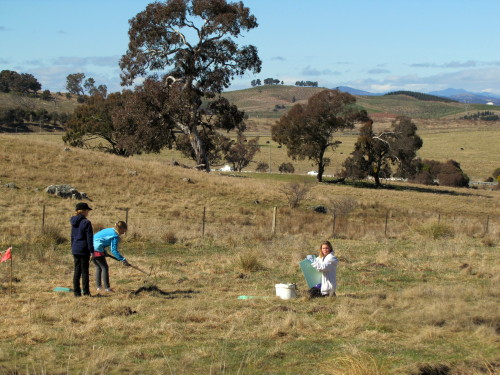
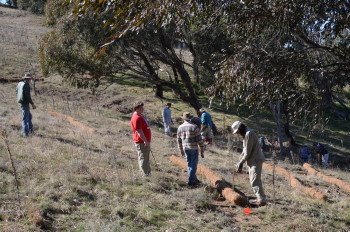
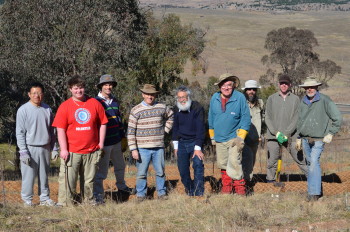
 The second fotpin AGM was held last Sunday (22nd July) at Weetangera Primary and attended by 18 people in all, including Mary Porter AM MLA and PCS Ranger Craig Wainwright, who acted as returning officer. The incoming Coordinating Committee would like to thank Mary and Craig for their time and for the helpful and informative talks they were each kind enough to present.
The second fotpin AGM was held last Sunday (22nd July) at Weetangera Primary and attended by 18 people in all, including Mary Porter AM MLA and PCS Ranger Craig Wainwright, who acted as returning officer. The incoming Coordinating Committee would like to thank Mary and Craig for their time and for the helpful and informative talks they were each kind enough to present. 